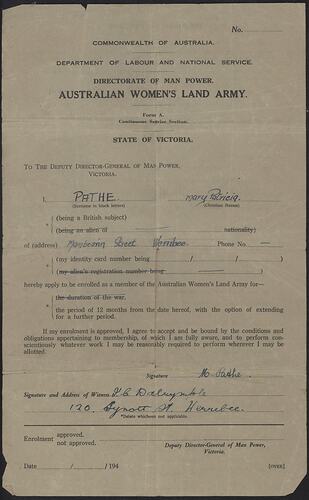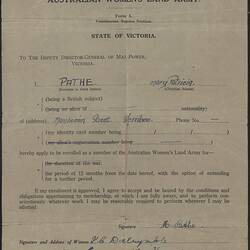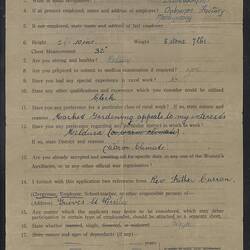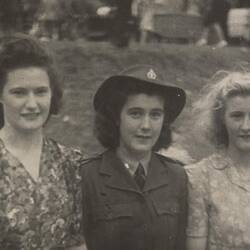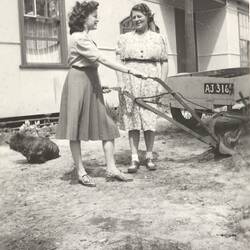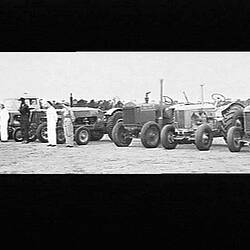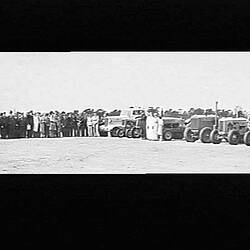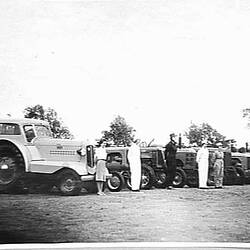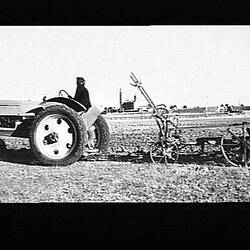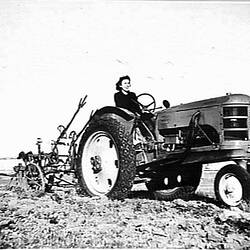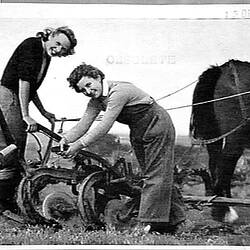Summary
Alternative Name(s): Application Form - AWLA
Single page Australian Women's Land Army application form, printed on brown paper. Completed, but not dated or submitted.
The form was issued during World War II by the Commonwealth of Australia Department of Labour and National Service, Directorate of Man Power (aka Manpower), 'Continuous Service Section', State of Victoria.
The document was filled in by the donor's father's sister, Mary Patricia Pathe. She was probably unwell at the time with tuberculosis (on the form she wants to go to Mildura 'or warm climate'). She was living at home with her family when she applied, in a World War I soldier settlement house in Werribee.
The form explains that Mary was born on 16 September 1926. She is working as a storewoman at the 'Ordnance Factory' at Maribyrnong. She is 5'10" tall, and weights 8 stone 7 pounds (54kg). She describes her health as 'medium'. She has had no experience at rural work, although she says that 'market gardening appeals to my interests'. She feels she could be utilized as a clerk. She applies for a 12-month period, renewable, rather than for the duration of the war.
The work would have been challenging for someone not in good health. The Women's Land Army working week averaged 48 hours, and required a range of agricultural activities associated with vegetable and fruit growing and animal husbandry (pig and poultry raising, and sheep and wool work).
Mary never submitted the form. Perhaps it was due to her ill-health; perhaps she was not old enough when she wanted to apply. Land Army recruits had to be at least 18 years old, and Mary only turned 18 in September 1944, less than a year before the war ended. She died shortly afterwards in 1947, aged just 20.
A lock of Mary's hair is still held by her family.
Further notes regarding form: the address of Mary's referee, Rev. Father Curran, should be 'Greaves St' rather than 'Grieves St', Werribee. Mary's next-of-kin was her mother Mrs Thow - first names Cath Mary. Mary's father had passed away, and her mother had re-married.
Physical Description
Single-page form, printed in black ink on brown paper. Dotted lines for information to be filled in - partly filled in with hand-written ink, but date and approval missing. Has been folded into eight pieces - folds now deep, but not broken. Deep corner folds and some edge losses.
Significance
This Australian Women's Land Army application form is particularly rare as it documents the process of individual application to the Women's Land Army. Historic records of the Women's Land Army largely relate to recruitment advertisements and service - for instance, the National Archives digitized records of the Women's Land Army do not include application forms, but only cards recording service. More significantly, the application form is of known provenance, and documents an unsuccessful process of application, probably due to ill-health.
The Australian Women's Land Army (AWLA) was formed on 27 July 1942 to combat rising labour shortages in the farming sector during World War II. Although a national body under the jurisdiction of the Director General of Manpower, its organisation was State-based. An active recruiting campaign was undertaken for members, including colourful poster advertisements. Recruits were largely drawn from urban areas and were often unskilled in rural work; women who were farmers, employees or relatives of land holders were not allowed to enlist. Enrolment peaked at 2,382 permanent members and 1,039 auxiliary members in December 1943. Work covered both cultivation and animal husbandry, and averaged 48 hours per week. The Australian Women's Land Army was disbanded on 31 December 1945. (Australian War Memorial encyclopaedia 'Australian Women's Land Army', accessed 26/7/2011)
The other important feature of the Australian Women's Land Army application form is its testament to the continuing impact of tuberculosis during the war years. Tuberculosis had long been a major cause of debility and death, but by World War II treatment mass radiological chest screening and effective bacteriological examination of army recruits at least resulted in reliable diagnosis. ('The epidemiology, mortality and morbidity of tuberculosis in Australia: 1850-94', H.E. Williams, 1995). The following decades finally saw effective treatment of tuberculosis, particularly with the introduction of the antibiotic streptomycin. Vaccines were also introduced after the war which dramatically lowered the incidence of tuberculosis.
More Information
-
Collecting Areas
-
Acquisition Information
Donation from Ms Janet Pathe, 29 Sep 2010
-
Person Named
Mary P. Pathe, Mambourin Street, Werribee, Greater Melbourne, Victoria, Australia, 1942-1945
-
Organisation Named
-
Publisher
Department of Labour and National Service, Commonwealth of Australia, Australia, 1942-1945
-
Inscriptions
Extensive printed text. Headed 'COMMONWEALTH OF AUSTRALIA. / DEPARTMENT OF LABOUR AND NATIONAL SERVICE / DIRECTORATE OF MAN POWER. / AUSTRALIAN WOMEN'S LAND ARMY. / Form A. / Continuous Service Section / STATE OF VICTORIA / TO THE DEPUTY-DIRECTOR OF MAN POWER, VICTORIA'. The form is filled in with ink by Mary Patricia Pathe of Mambourin Street, Werribee, 'hereby applied to be enrolled as a member of the Australian Women's Land Army for - / the duration of the war [latter crossed out] / the period of 12 months from the date hereof, with the option of extending / for a further period.' The form is signed and witnessed, but not signed by the Deputy-Director General of Man Power or dated. Personal details are provided on the back of the form.
-
Classification
-
Category
-
Discipline
-
Type of item
-
Overall Dimensions
250 mm (Width), 333 mm (Height)
-
References
Australian War Memorial web site [Link 1] accessed 26/7/2011 'The epidemiology, mortality and morbidity of tuberculosis in Australia: 1850-94'. H.E. Williams, Journal of Paediatric Child Health. 1995 Dec; 31(6):495-8.
-
Keywords
Tuberculosis, Women's Land Army, World War II, 1939-1945, Soldier Settlements
